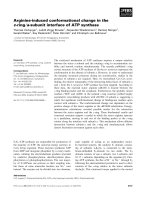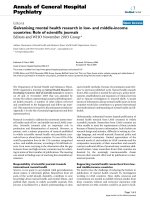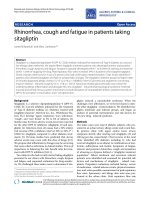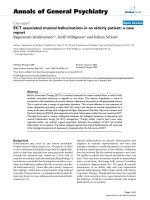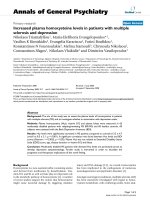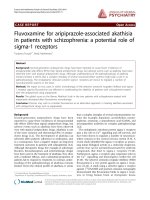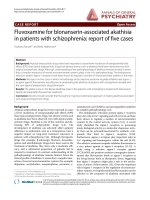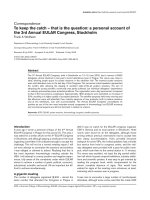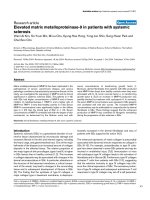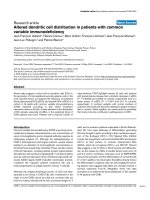Báo cáo y học: "Fluvoxamine for aripiprazole-associated akathisia in patients with schizophrenia: a potential role of sigma-1 receptors" ppt
Bạn đang xem bản rút gọn của tài liệu. Xem và tải ngay bản đầy đủ của tài liệu tại đây (193.5 KB, 3 trang )
CAS E REP O R T Open Access
Fluvoxamine for aripiprazole-associated akathisia
in patients with schizophrenia: a potential role of
sigma-1 receptors
Tsutomu Furuse
1*
, Kenji Hashimoto
2
Abstract
Background: Second-generation antipsychotic drugs have been reported to cause fewer incidences of
extrapyramidal side effects (EPSs) than typical antipsychotic drugs, but adverse events such as akathisia have been
observed even with atypical antipsychotic drugs. Although understanding of the pathophysiology of akathisia
remains limited, it seems that a complex interplay of several neurotransmitter systems might play a role in its
pathophysiology. The endoplasmic reticulum protein sigma-1 receptors are shown to regulate a number of
neurotransmitter systems in the brain.
Methods: We report on two cases in which monotherapy of the selective serotonin reuptake inhibitor and sigma-
1 receptor agonist fluvoxamine was effective in ameliorating the akathisia of patients with schizophrenia treated
with the antipsychotic drug aripiprazole.
Results: The global score on the Barnes Akathisia Scale in the two patients with schizophrenia treated with
aripiprazole decreased after fluvoxamine monotherapy.
Conclusion: Doctors may wish to consider fluvoxamine as an alternative approach in treating akathisia associated
with antipsy chotic drugs such as aripiprazole.
Background
Second-generation antipsychotic drugs have been
reported to cause fewer incidences of extrapyramidal
side effects (EPSs) than typical antipsychotic drugs, b ut
adverse events such as akathisia have been observed
even with atypical antipsychotic drugs. Akathisia is one
of the most common and distressing EPSs of antipsy-
chotic drugs [1,2]. The development of akathisia can
adversely affect patients’ adherence to medication, and,
as a consequence, have a negative impact on long-term
treatment outcomes in patients with schizophrenia [3,4].
Although therapeutic drugs (for example, b-a drenergic
blockers, benzodiazepines, a nd anticholinergic drugs)
have been used in the treatment of akathisia, they show
only a moderate efficacy, and a substantial proportion of
patients fail to respond to treatment. In contrast, under-
standing of the pathophysiology of akathisia rema ins
limited. Given the clinical profile of akathisia, it seems
that a complex interplay of several neurotransmitter sys-
tems (for example, dopamine, acetylcholine, norepi-
nephrine, serotonin, g-aminobutyric acid (GABA), and
neuropeptides) underlies its complex pathophysiology
[1,2].
The endoplasmic reticulum protein sigma-1 receptors
play a key role in Ca
2+
signalling and cell survival, and
have been shown to regulate a number of neurotrans-
mitter systems in the central nervous system [5-8]. A
recent study identified the sigma-1 receptors as posses-
sing innate biological activity as a molecular chaperone,
activity that can be activated/inactivated by synthetic
compounds that bind to sigma-1 receptors [9,10].
Furthermore, sigma-1 receptors play important roles in
the Ca
2+
signalling and bioenergetics within the cell
[8-10 ]. The selective serotonin reuptake inhibitor ( SSRI)
fluvoxamine is a very potent agonist on sigma-1 recep-
tors [11,12]. A study using a selective sigma-1 receptor
agonist [
11
C]SA4503 and positron emission tomography
demonstrated that fluvoxamine binds to sigma-1 recep-
tors in living human brain at therapeutic doses,
* Correspondence:
1
Department of Psychiatry, Asahikawa Red Cross Hospital, Asah ikawa, Japan
Furuse and Hashimoto Annals of General Psychiatry 2010, 9:11
/>© 2010 Furuse and Hashimoto; licensee BioMed Central Ltd. This is an Open Access article distributed under the terms of the Creative
Commons Attribution License ( which permits unrestricted use, distribution , and
reprodu ction in any medium, provided the original wor k is properly cite d.
suggesting that sigma-1 receptors might play a role in
the mechanism of action of fluvoxamine [13].
Given the important role o f sigma-1 receptors in the
regulation of neurotransmitter systems, we hypothesised
that fluvoxamine may be effective in the treatment of
akathisia associated with antipsychotic treatment. Aripi-
prazole is an antipsychotic drug that acts as a partial
agonistatdopamineD
2
receptors and serotonin 5-
hydroxytryptamine (5-HT)
1A
receptors, and an antago-
nist at 5-HT
2A
receptors. The Schizophrenia Trial o f
Aripiprazole (STAR) study demonstrated a relatively
higher incidence of akathisia with aripiprazole compared
with placebo or other antipsychotic drugs (olanzapine,
quetiapine, or risperidone)[14]. Here, we report two
cases in which fluv oxamine was effective in treating ari-
piprazole-induced akathisia in patients with schizophre-
nia. Written informed consents were obtained from the
all patients in this case report.
Case reports
Case 1
The patient was a 24-year-old woman who met the
Diagnostic and Statistical Manual of Mental Disorders,
fourth edition (DSM-IV) criteria for schizo phrenia.
Treatment with aripiprazol (12 mg) was initiated; 2 days
later, the patient complained of leg restlessness. Her glo-
bal score on the Barnes Akathisia Scale [15] was 3
(’moderate akathisia’). Fluvoxamine (50 mg, twice a day)
was administered. Substantial relief of akathisia was
noted on day 7 of fluvoxamine treatment. The dose of
aripiprazole was increased to 24 mg, since she still had
persecutory delusions and aud itory hallucinations. Flu-
voxamine (50 mg) continued to be administered. After 3
weeks, she had no recurrence of the akathisia.
Case 2
The patient was a 41-ye ar-old man who met the DSM-
IV criteria for schizophrenia. Because of quetiapine-
induced body weight gain, the antipsychotic drug was
changed to aripiprazole (6 mg). He showed signs of
akathisia after the dose of aripiprazole was increased to
12 mg. His global score on the Barnes Akathisia Scale
was 3. Administration of fluvoxamine (50 mg, twice a
day) rapidly improved the akathisia. He showed no signs
of akathisia after the dose of aripiprazole was increased
to 24 mg, his body weight decreased, and his mental sta-
tus was stable.
Discussion
To our knowledge, this is the first report demonstrating
that fluvoxamine is effective in the treatment of aripi-
prazole-induced akathisia of patients with schizophrenia.
Furthermore, we have experien ced that fluvoxamine is
also effective in the treatment of other antipsychotic-
induced akathisia in patients with schizophrenia (data
not shown). Nonetheless, a randomised double-blind,
placebo-controlled study of fluvoxamine will be needed
to confirm its efficacy for the treatment of this syn-
drome. From these case s tudies, it is unclear whether
sigma-1 receptor agonism appears to be irrelevant to
the anti-akathitic action of fluvoxamine. In ord er to
confirm the role of sigma-1 receptors in the treatment
of akathisia, a randomised double-blind, placebo-con-
trolled study of the selective sigma-1 receptor agonist
(for example, cutamesine (SA4503)) in patients with
antipsychotic-induced akathisia w ould be also o f
interest.
Akathisia is a neurological side effect of antipsychotic
medications, which are used to treat various psychiatric
disorders such as schizophrenia and bi polar disorders
[1,2,4]. It seems that akathisia is simply a dopamine D
2
receptor blockade [1] although t he precise mechanisms
underlying antipsychotic drugs-induced akathisia are
currently unclear. A number of neurotransmitter sys-
tems play a role in the complex pathophysiology of
akat hisia [1,2]. At present, it is unclear whether sigma-1
receptor agonism is involved in the mechanisms of anti-
akathitic action of fluvoxamine. Co nsidering the impor-
tant role of sigma-1 receptors in the regulation of a
number of neurotransmitter systems [5-8], it is likely
that indirect modulation of several neurotransmitter sys-
tems by sigma-1 receptor agonist may be involved i n
the mechanisms of this drug although a further detailed
study will be necessary.
Conclusions
These t wo cases suggest tha t fluvoxamine may serve as
an alternative option in the treatment of antipsychotic-
induced akathisia in patients with schizophrenia. More
detailed randomised, double-blind studies of fluvoxa-
mine using larger samples should be performed to clar-
ify the role of sigma-1 receptors in the efficacy of
fluvoxamine for akathisia.
Author details
1
Department of Psychiatry, Asahikawa Red Cross Hospital, Asah ikawa, Japan.
2
Division of Clinical Neuroscience, Chiba University Center for Forensic
Mental Health, Chiba, Japan.
Authors’ contributions
TF contributed to the clinical and rating evaluations during the follow-up
periods. KH conceived of the study and participated in its study and
coordination. All authors read and approved the final manuscript.
Competing interests
The authors declare that they have no competing interests.
Received: 28 January 2010 Accepted: 6 March 2010
Published: 6 March 2010
Furuse and Hashimoto Annals of General Psychiatry 2010, 9:11
/>Page 2 of 3
References
1. Iqbal N, Lambert T, Masand P: Akathisia: problem of history or concern of
today. CNS Spectr 2007, 12(Suppl 14):1-13.
2. Kane JM, Fleischhacker WW, Hansen L, Perlis R, Pikalov A, Assunção-
Talbott S: Akathisia: an updated review focusing on second-generation
antipsychotics. J Clin Psychiatry 2009, 70:627-643.
3. Kane JH: Extrapyramidal side effects are unacceptable. Eur
Neuropsychopharmacol 2001, 11(Suppl 4):S397-S403.
4. Kane JM, Barnes TR, Correll CU, Sachs G, Buckley P, Eudicone J, McQuade R,
Van Tran Q, Pikalov A, Assunção-Talbott S: Evaluation of akathisia in
patients with schizophrenia, schizoaffective disorder, or bipolar I
disorder: a post hoc analysis of pooled data from short- and long-term
aripiprazole trials. J Psychopharmacol 2010.
5. Hayashi T, Su TP: Sigma-1 receptor ligands: potential in the treatment of
neuropsychiatric disorders. CNS Drugs 2004, 18:269-284.
6. Hashimoto K, Ishiwata K: Sigma receptor ligands: possible application as
therapeutic drugs and as radiopharmaceuticals. Curr Pharm Des 2006,
12:3857-3876.
7. Maurice T, Su TP: The pharmacology of sigma-1 receptors. Pharmacol Ther
2009, 124:195-206.
8. Ishikawa M, Hashimoto K: The role of sigma-1 receptors in the
pathophysiology of neuropsychiatric diseases. J Receptor Ligand Channel
Res 2010, 3:25-36.
9. Hayashi T, Su TP: Sigma-1 receptor chaperones at the ER-mitochondrion
interface regulate Ca
2+
signaling and cell survival. Cell 2007, 131:596-610.
10. Hayashi T, Stahl SM: The sigma-1 receptor and its role in the treatment
of mood disorders. Drugs Future 2009, 34:137-146.
11. Narita N, Hashimoto K, Tomitaka S, Minabe Y: Interactions of selective
serotonin reuptake inhibitors with subtypes of sigma receptors in rat
brain. Eur J Pharmacol 1996, 307:117-119.
12. Hashimoto K: Sigma-1 receptors and selective serotonin reuptake
inhibitors: clinical implications of their relationship. Cent Nerv Syst Agents
Med Chem. 2009, 9(3):197-204.
13. Ishikawa M, Ishiwata K, Ishii K, Kimura Y, Sakata M, Naganawa M, Oda K,
Miyatake R, Fujisaki M, Shimizu E, Shirayama Y, Iyo M, Hashimoto K: High
occupancy of sigma-1 receptors in the human brain after single oral
administration of fluvoxamine: a positron emission tomography study
using [
11
C]SA4503. Biol Psychiatry 2007, 62:878-883.
14. Kerwin R, Millet B, Herman E, Banki CM, Lublin H, Pans M, Hanssens L,
L’Italien G, McQuade RD, Beuzen JN: A multicentre, randomized,
naturalistic, open-label study between aripiprazole and standard of care
in the management of community-treated schizophrenic patients.
Schizophrenia Trial of Aripiprazole: (STAR) study. Eur Psychiatry 2007,
22:433-443.
15. Barnes TR: A rating scale for drug-induced akathisia. Bri J Psychiatry 1989,
154:672-676.
doi:10.1186/1744-859X-9-11
Cite this article as: Furuse and Hashimoto: Fluvoxamine for aripiprazole-
associated akathisia in patients with schizophrenia: a potential role of
sigma-1 receptors. Annals of General Psychiatry 2010 9:11.
Submit your next manuscript to BioMed Central
and take full advantage of:
• Convenient online submission
• Thorough peer review
• No space constraints or color figure charges
• Immediate publication on acceptance
• Inclusion in PubMed, CAS, Scopus and Google Scholar
• Research which is freely available for redistribution
Submit your manuscript at
www.biomedcentral.com/submit
Furuse and Hashimoto Annals of General Psychiatry 2010, 9:11
/>Page 3 of 3
